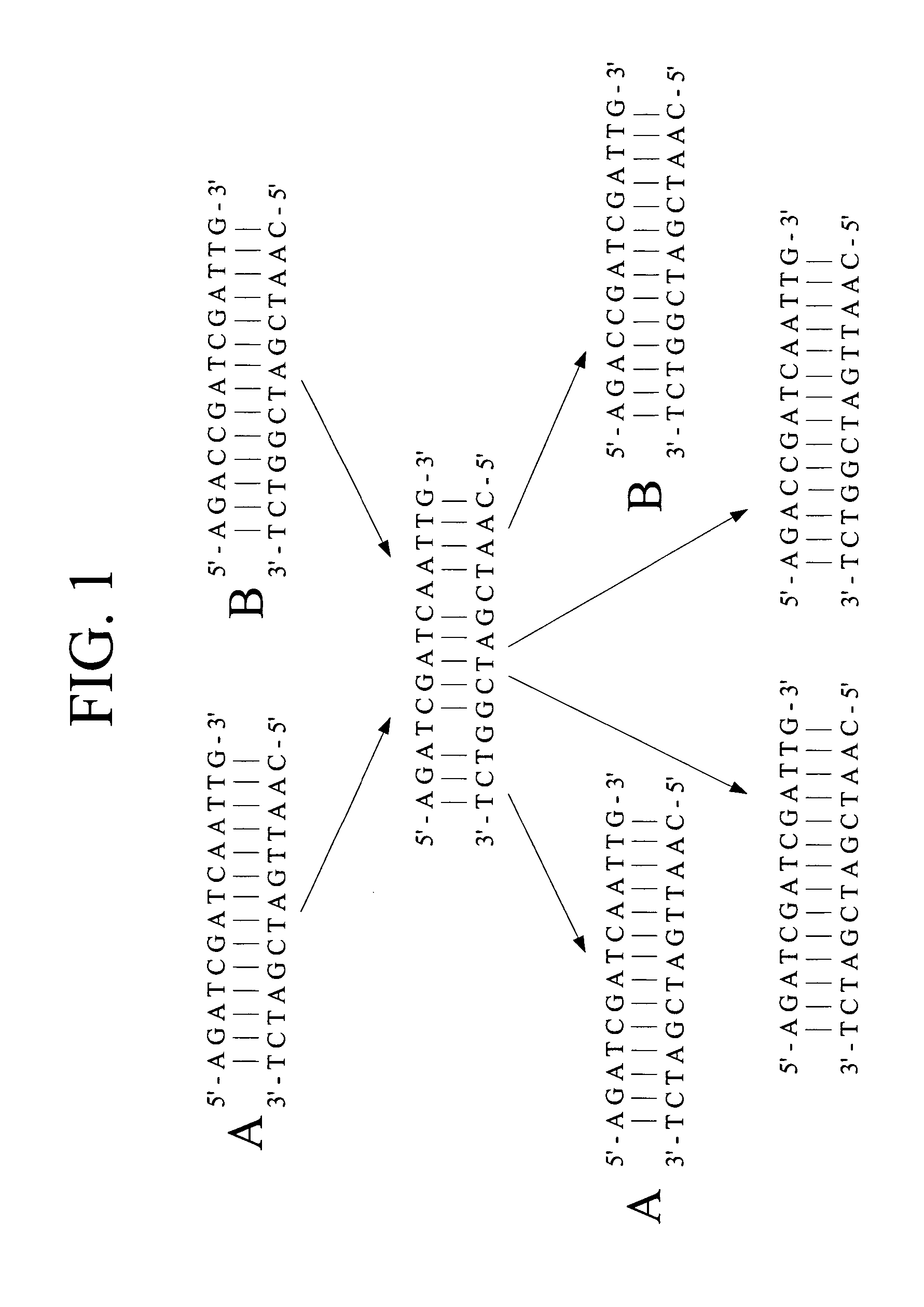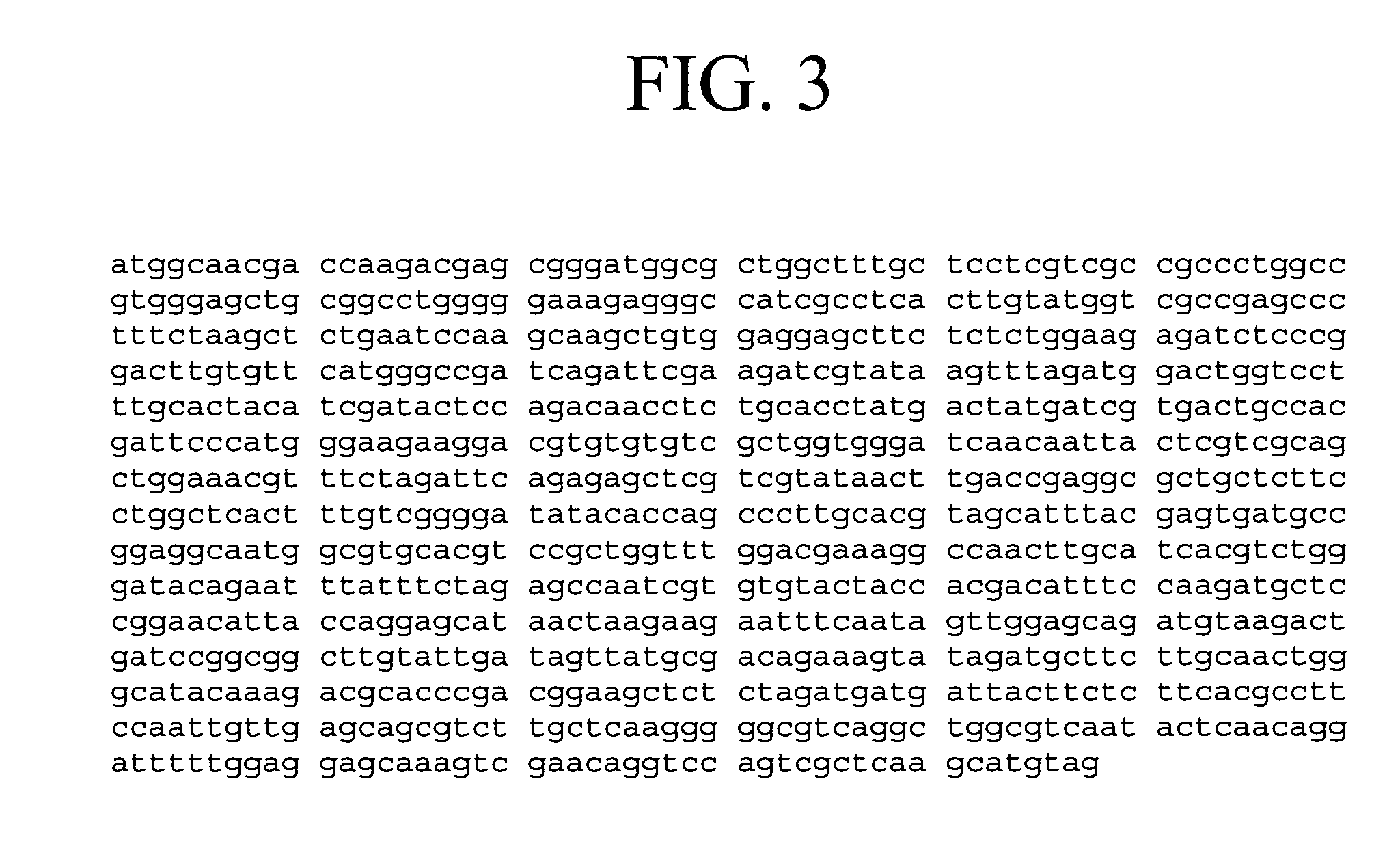Polynucleotide sequence variants
a polynucleotide sequence and variant technology, applied in the field of polynucleotide sequence variants, can solve the problems of increasing the ratio of deleterious mutations to beneficial mutations, tedious and laborious process, and increasing the rate at which sequences incur mutations with undesirable effects
- Summary
- Abstract
- Description
- Claims
- Application Information
AI Technical Summary
Benefits of technology
Problems solved by technology
Method used
Image
Examples
example 2
Conservation of Full Length GFP Gene with Mismatch Resolution Cocktails
[0227] This example teaches various mismatch resolution cocktails that conserve the full length GFP Gene.
[0228] Mismatched GFP substrate was treated with various concentrations of CEL I in the presence of cocktails of enzymes that together constitute a synthetic mismatch resolution system. The enzymes used were CEL I, T4 DNA polymerase, Taq DNA polymerase and T4 DNA ligase. CEL I activity should nick the heteroduplex 3' of mismatched bases. T4 DNA polymerase contains 3'-5' proofreading activity for excision of the mismatched base from the nicked heteroduplex. T4 DNA polymerase and Taq DNA polymerase contain DNA polymerase capable of filling the gap. T4 DNA ligase seals the nick in the repaired molecule. Taq DNA polymerase also has 5' flap-ase activity.
[0229] Matrix experiments were performed to identify the reaction conditions that would serve to resolve mismatches in the GFP heteroduplex substrate. In one experi...
example 3
Restoration of Restriction Sitesto GFP Heteroduplex DNA after DNA Mismatch Resolution (GRAMMR)
[0235] This experiment teaches the operability of genetic reassortment by DNA mismatch resolution (GRAMMR) by demonstrating the restoration of restriction sites.
[0236] The full-length products of a twenty-fold scale-up of the GRAMMR reaction, performed at 37.degree. C. for one hour, using the optimal conditions found above (the 1.times. reaction contained sixty nanograms of heteroduplex DNA, one microliter of CEL I fraction five (described in Example 1), one unit T4 DNA polymerase in the presence of 2.5 units of Taq DNA polymerase and 0.2 units of T4 DNA ligase in 1.times.NEB T4 DNA ligase buffer containing 0.5 mM of each dNTP in a reaction volume of 10 microliters) were gel-isolated and subjected to restriction analysis by endonucleases whose recognition sites overlap with mismatches in the GFP heteroduplex, thereby rendering those sites in the DNA resistant to restriction enzyme cleavage....
example 4
GRAMMR-Treated GFP Genes
[0239] This example demonstrates that GRAMMR can reassort sequence variation between two gene sequences in a heteroduplex and that there are no significant differences in GRAMMR products that were directly cloned, or PCR amplified prior to cloning.
[0240] The GRAMMR-treated DNA molecules of Example 3 were subsequently either directly cloned by ligation into pCR-Blunt II-TOPO (Invitrogen), or amplified by PCR and ligated into pCR-Blunt II-TOPO according to the manufacturer's instructions, followed by transformation into E. coli. After picking individual colonies and growing in liquid culture, DNA was prepared and the sequences of the GFP inserts were determined. As negative controls, the untreated GFP heteroduplex substrate was either directly cloned or PCR amplified prior to cloning into the plasmid.
[0241] In GRAMMR, reassortment of sequence information results from a process of information transfer from one strand to the other. These sites of information tran...
PUM
| Property | Measurement | Unit |
|---|---|---|
| Fraction | aaaaa | aaaaa |
| Length | aaaaa | aaaaa |
Abstract
Description
Claims
Application Information
 Login to View More
Login to View More - R&D
- Intellectual Property
- Life Sciences
- Materials
- Tech Scout
- Unparalleled Data Quality
- Higher Quality Content
- 60% Fewer Hallucinations
Browse by: Latest US Patents, China's latest patents, Technical Efficacy Thesaurus, Application Domain, Technology Topic, Popular Technical Reports.
© 2025 PatSnap. All rights reserved.Legal|Privacy policy|Modern Slavery Act Transparency Statement|Sitemap|About US| Contact US: help@patsnap.com



